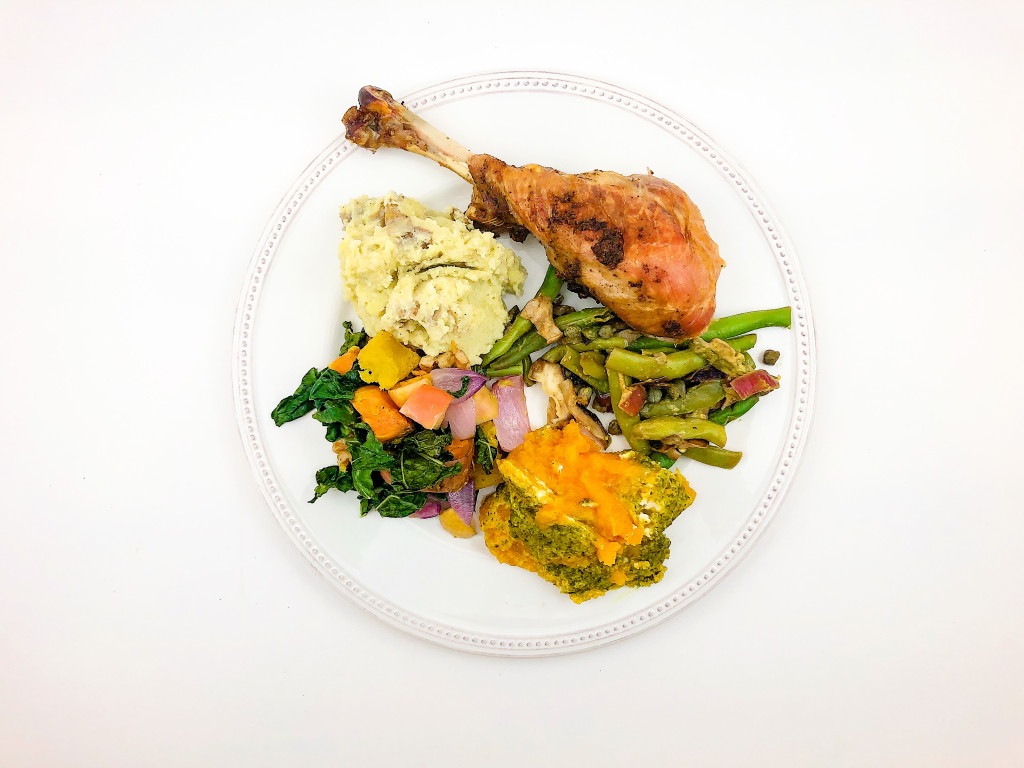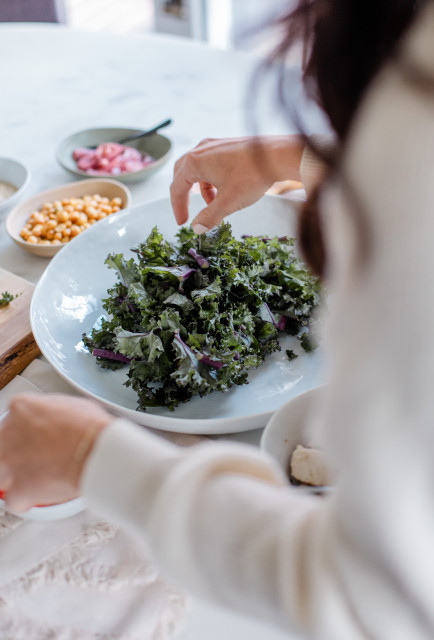
Your Healthy Holiday Eating Guide
The holiday season can lead to an increased exposure to cut-out sugar cookies, sugar-laden pumpkin pie, decadent chocolate boxes and wine. If that weren’t enough, people’s schedules are typically filled with holiday parties where they serve trays of overindulgent foods that light up the pleasure center of your brain and translate to less than desirable health outcomes. Here’s the thing: It is entirely possible to enjoy the holidays without excessively indulging in high glycemic foods and alcohol but that also does not mean depriving yourself of all of the delicious foods and beverages that you love.
So, cut yourself some slack this season! Here’s my advice for sailing through the holidays while both enjoying yourself and setting yourself up for success:
Tip 1: Follow My Optimal Plate Method
My key recommendation is to control your blood sugar levels as often as possible and integrate optimal anti-inflammatory choices into all of your meals. Use this structure the day of your holiday parties to prevent you from skipping meals to try to “save calories”. Leading up to the holiday meals and during the holiday meals, follow my Optimal Plate Method.
Try to also use this as a flexible guide when you are at holiday parties. This includes an abundance of phytonutrient-rich non-starchy vegetables, protein, and healthy fats, in addition to an optional serving of starchy carbohydrates. Fill half of your plate with non-starchy vegetables like green beans, salad or roasted brussels sprouts that will make you feel more full. Add protein from turkey, chicken, lamb or tofu/beans. Incorporate healthy fats which will likely already be cooked into the dishes (ex: olive oil, avocado, etc.) to decrease spikes in glucose levels. Then layer in starchy carbohydrates like mashed potatoes, butternut squash or stuffing as a quarter of your plate. And then add one of your favorite desserts, if you feel like it.
Tip 2: Surrender to What is Not in Your Control
When you’re at family gatherings or events, it can be especially difficult to have control over the quality of the food you eat. The chicken may not be organic, the almond milk may have some sugar in it, the dressing will likely not have an extra virgin olive oil base—and that’s OK. It’s more important to enjoy the experience and the people around you than stress over whether your beef satay is organic. If you have food sensitivities or allergies, that’s a different story! You’ll have to pay closer attention to what’s on the buffet. But even in that case, it is possible to enjoy yourself. Just don’t stress if it’s not organic!
Tip 3: Drink One Glass of Water In Between Every Glass of Alcohol
Drinking too much alcohol will not just spike your blood sugar levels but it can also lead to eating foods you wouldn’t otherwise eat at a holiday party and feeling unmotivated to eat well the day after. In addition to that, alcohol interferes with quality sleep. Research shows that inadequate sleep alters your hormone levels, driving you to eat more high glycemic foods the next day. The recommendation is for men to drink two glasses of alcohol per day and women to drink one. When drinking alcohol, avoid other beverages that will further spike blood sugar such as soda and opt for club soda. Aim for drinking one glass of seltzer water with a lime in between every glass of alcohol to help you stay hydrated.
Tip 4: Find More Nutritious Substitutions
There are simple substitutions that you can make to recipes to make them better for you. Just because your traditional family pie recipe has been made with 65g of added sugar per slice for the last 30 years does not mean you can’t modify the recipe. In my experience, everytime our family modifies recipes that have been passed down for three generations, everyone enjoys them just as much and they usually feel better after the meal.
If you have non-negotiables in your diet due to health reasons like food sensitivities, diabetes, or IBS, then you will want to make further substitutions. If you are trying to avoid gluten, dairy, added sugars, refined carbohydrates, etc. then plan a few recipes that cater to your dietary needs that other people may enjoy trying as well. If you know you are going to feel horrible after eating too much gluten or dairy, then transition some of your recipes to gluten-free and dairy-free! I also created a free recipe guide that you can download here. Here are some of my top swaps:


Tip 5: Plan for Less Optimal Choices
If you want to try to eat well and avoid the dessert table three times in one night, plan your meal in advance with light structure. In the planning exercise, focus on 1-2 less optimal choices that you are going to eat at your holiday meal. If you know you really want two glasses of wine or a piece of pumpkin pie, give yourself permission in advance to eat/drink this and enjoy it. This is of course assuming that you do not have a food sensitivity to gluten or dairy!
This is not about eating good foods or bad foods, cheat meals or “on plan” meals. There are always optimal and less optimal food choices. The goal is to simply make optimal food choices whenever possible and to plan those less optimal foods into your dinner.
Tip 6: Pack In the Vegetables Before the Party
Try eating several non-starchy vegetables before you head to a party. If the party doesn’t serve many vegetables then that’s fine! You loaded up in advance! Loading up on vegetables that contain fiber helps slow down gastric emptying and the breakdown of carbohydrates in the small intestine which leads to lower surges in blood sugar levels. This process helps to increase compounds that signal to the hypothalamus that you are satisfied.
Headed to a potluck? Challenge yourself to bring a veggie dish that’ll turn your family or friends on to your veggie-packed diet. Some great options include my Kale Pear & Lemon Chicken Salad (baked chicken is optional) or Shredded Crucifer Salad. Bonus: It’ll guarantee that there’ll be at least one fiber-rich food source at the party!
Tip 7: Put your Fork Down Between Bites
In order to fully absorb the nutrients that you consume, you will want to be in a calm and relaxed state. Eating quickly and feeling stressed puts you in a fight-or-flight state. This makes it impossible for your body to adequately digest and absorb the food you are eating. Feeling frazzled can also drive more sugar cravings. My best tip is simple and realistic when you’re eating with others: Simply aim to put your fork down between every bite of food that you take. When you do this, you might also take a sip of water, or just focus on being present with the people around you. It’s a great way to eat a little slower, savor your food, pay attention to the flavors and colors, and to be more mindful about what you’re eating and who you’re with!
Tip 8: Narrow your Window of Eating
This is the concept of restricting your eating window to 8-10 hours during the day. For example, you may consume food from 10am to 6-8pm and then abstain from eating overnight from 6-8pm to 10am. For some, waiting a few hours after waking up to eat your first meal can significantly help to reduce cravings throughout the rest of the day and utilize your glycogen stores, allowing for fatty acid oxidation. You may want to choose to practice time restricted eating the day of a holiday dinner and/or the day after. As an added bonus, restricting your eating window has been associated with human growth hormone stimulation, cognitive enhancement, and autophagy, which is the body’s way of resetting your cells.
Tip 9: Do These Two Things if you Overeat
There are going to be times when you overeat or have more sugar for dessert than usual. When that does happen, there are two simple tricks you can use to help lower your postprandial glucose levels and keep insulin (and future food cravings) in check: Add 1-2 Tablespoons of Bragg apple cider vinegar to 8 fluid ounces of water after your meal, which may be associated with lower post-meal glucose levels. The mechanism is not exactly clear but acetic acid, the key ingredient in apple cider vinegar, is thought to interfere with the breakdown of carbohydrates and/or promote glucose uptake by the muscle.
A second highly effective way to lower your post-prandial glucose levels is going for a walk! Even a stroll around the block will help decrease postprandial glucose levels by increasing glucose uptake by the skeletal muscle. Peak post meal glucose levels typically occur within 90 minutes of a meal. It’s thought that post-meal exercise as soon as 30 minutes after a meal is optimal to help blunt peak glucose excursions.
Tip 10: Avoid the What the Hell Effect
The What the Hell Effect is a term that I coined to describe what happens when a person tries to be so perfect with their diet. It’s the act of “getting off track” with your diet for one meal and allowing it to sabotage you in the future. Example: “I ate a piece of pie last night at the party so, what the hell, I might as well eat a piece of cake with lunch today.” It’s this idea of “getting the most out of being off track” that interferes with a sustainable approach to eating.
But rather than letting yourself feel like a failure for abandoning your plan, give yourself grace. Understand that there are “optimal eating days/choices” and “less optimal eating days/choices.” If you eat something that does not make you feel great, it does not make you a bad person. It means you made a less optimal choice. The good news is that there is no judgement attached to the action and you have the flexibility to make a new choice at your next meal. When you encounter situations where you overdo it on the less nutrient dense foods, it’s imperative that you rebound as quickly as possible.



